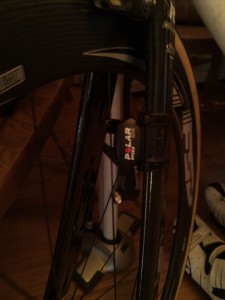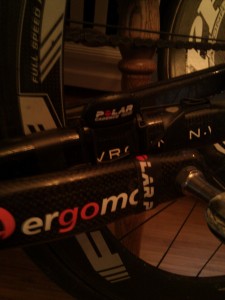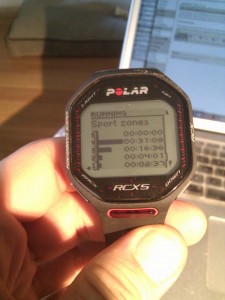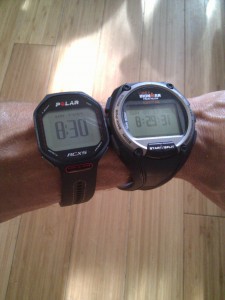A few weeks ago I was very fortunate to receive an evaluation RCX5 from Polar to review for the readers of my blog. I’d hoped to get the complete configuration, that included the watch, hrm, gps, foot pod, and bike cadence and speed sensors; however, unfortunately, there are no gps units to be found. 🙁 That being said, Polar did ship me all the other parts of the kit for evaluation. Pretty awesome!
First Impressions
My current training watch is the Timex Ironman Global Trainer. I generally like the Timex, but it’s not without it’s problems: it’s huge, needs constant charging, and the HRM transmitter is not compatible with the powermeter cpu on my bike. When I unpacked the RCX5 I was immediately struck by how much smaller it is than my timex.
The polar is small and stylish enough that you could just wear it as a day to day watch. This makes sense as the GPS functionality that’s built into the Timex is a separate piece of equipment with the RCX5.
Swim
The evaluation kit arrived at my office on a Friday afternoon a few weeks ago. Lately Fridays have been my open water swim day. This Friday was not an exception and I was eager to take the RCX5 into the water. Not having hrm data from my swim sessions, I find very annoying. (Yes I’m a data monkey, I know it. As a triathlete, I also know I’m not alone in my hunger for performance data and desires to use that data to improve.) I was definitely watching the clock to get out of the office and to the beach to give the RCX5 a test in some open water, with a wetsuit on. Happy to report: the RCX5 worked flawlessly in the water. It collected heart-rate data through my entire 1.5hr swim.
Data Upload/PolarPersonalTrainer.com
Later, when I got home, I installed the Polar Websync software, uploaded the workout to Polar’s site and exported the data so that I could upload it to TrainingPeaks.com. The watch sync is done wirelessly to a USB dongle, this is pretty nice. My desk and livingroom chair areas are scattered with cables from various devices. Wireless (and not infrared) is definitely a big improvement that Polar has brought forward with the RCX5. Polar’s website is pretty nice, it allows you to do some pretty good detailed analysis of the workout.
I’ve been training and capturing my training data to trainingpeaks.com for far too long to even think about moving (and Polar’s site is really about workout/training analysis, and doesn’t have the nutrition tracking and other features that trainingpeaks has). At this time there is no sync of data between Polar’s website and Trainingpeaks.com. You have to manually export and upload your workout data to trainingpeaks.com. I’m told that many have asked for this integration and that it’s high on Polar’s priority list. The export and manual upload isn’t difficult, it’s just an extra step that would be nice to have automatic. Syncing workouts to dailyburn would also be a plus 🙂
Run
Saturday is long-run day, so I strapped up the RCX5 foot pod, wore my Timex and the polar (and 2 hrm straps) and went for a 3 hr run. Once again, the RCX5 operated flawlessly. Even without calibration the foot pod measured my distance to within about 2km of that the Timex reported. Without the GPS module the RCX5, of course, didn’t capture my route data, but unfortunately, the run also highlighted something about the RCX5 that is a bit of a short-fall for me: the RCX5, even with the GPS module, does not capture altitude changes. This may not matter to some, but I frequently look back at workout logs and to not have the piece of data that explains that my HR and speed were doing odd things because I was climbing some heartbreak hill, is a definite gap.
Bike
Sunday was long ride day. On my bike I normally train with a power meter. Just having speed cadence and HR is definitely a step back for me, but I strapped up the sensors on my bike and we took it for a spin.


Other Features
One of the features that I didn’t spend a lot of time with on the RCX5 is the Zone Optimizer. I go for regular VO2Max testing and so have a much more accurate view of my HR zones than the Zone Optimizer could offer, yet as a test I did take it out for a run to see what it’d tell me. The zone optimizer measures your HR and activity as you are guided through some warmup steps. Based on how your body reacts to the warmups it sets a heart rate zone profile for you. In the small test I did it was surprisingly accurate. Certainly close enough for the average, not completely hung up on data, recreational athlete. I believe that the zone optimizer also takes past workout history data into account, so in theory, the more one used it, the more accurate it’d become.
I really love the customizable displays on the RCX5. Each sport has up to 6 workout displays that you can customize to display the data you most want to see at any given time. This is pretty slick and a smart use of a modern individually addressable lcd pixel display. My 2 favorite additions to the display were 2 graphs. One that shows graphically which HR zone you’re currently in and another graph that shows, for the workout, the distribution of your heart rate data broken down by zone.

Race Day
On July 16th I raced in the Gravenhurst Olympic Distance Triathlon (and then did a 10k training run afterwards). I decided to wear the RCX5 for the race as a final test. As before swim, bike and run data were captured without fail. Transitioning between 1 event and another is not quite as clean as the Global Trainer in it’s multisport mode and the RCX5 doesn’t capture transition timing (at least not obviously to me), but the RCX5 certainly was not at all cumbersome in this regard, it just required perhaps a few seconds more focus than the Timex (a happy compromise to get HRM data in the water and only wear 1 HRM strap on the bike I may add).
My Wish List
My wish list for the RCX5, all things that can be worked around without a lot of fuss btw:
- Multiple HR zone profiles: it’d be nice to be able to share an expensive piece of equipment like this between myself an my wife or, in my case, knowing that my HR zones are different between the 3 different sports being able to have HR zones tied to sport profiles would be AMAZING. No device on the market today has this feature and probably very few athletes would care, but I do 🙂
- Data sync between Polar’s website and TrainingPeaks, DailyMile, etc.
Final Thoughts
In summary, I think the RCX5 is a pretty great piece of technology. Unfortunately, I couldn’t test it with the GPS module, but I believe that with the GPS module and google maps, you could address the lack of altitude change capture by comparing your workout data to elevation change data from the mapping source. The RCX5’s modern technology, modular approach and flawless functionality make it a strong contender in the multi-sport space.
Thanks to Polar for the opportunity to evaluate this leading edge piece of gear!


Comments are closed